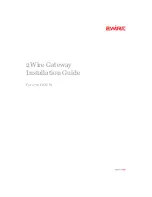
4.2 Other Installation Requirements
4.2 Reduce Chemical Exposure
Before installing any devices in a chemically harsh environment, contact the manufacturer for more information regarding
the life-expectancy. Solvents, oxidizing agents, and other chemicals will damage the devices.
4.2 Minimize Mechanical Stress
Although these radio devices are very durable, they are sophisticated electronic devices that are sensitive to shock and
excessive loading.
•
Avoid mounting the devices to an object that may be shifting or vibrating excessively. High levels of static force or
acceleration may damage the housing or electronic components.
•
Do not subject the devices to external loads. Do not step on them or use them as handgrips.
•
Do not allow long lengths of cable to hang from the glands on the Gateway or Node. Cabling heavier than 100
grams should be supported instead of allowed to hang from the housing.
•
Do not crack the housing by over-tightening the top screws. Do not exceed the maximum torque of 4 in-lbf.
It is the user’s responsibility to install these devices so they will not be subject to over-voltage transients. Always ground
the devices in accordance with local, state, or national regulations.
4.2 When Installing Performance or MultiHop 1-Watt Radios
Notice: This equipment must be professionally installed. The output power must be limited, through the use of firmware or
a hardware attenuator, when using high-gain antennas such that the +36 dBm EIRP limit is not exceeded.
4.3 Installation Quick Tips
The following are some quick tips for improving the installation of wireless network components.
4.3.1 Create a Clear Communication Path
Wireless communication is hindered by radio interference and obstructions in the path between the transmitter and
receiver. To achieve the best radio performance, carefully consider the installation locations for the Gateways and Nodes
and select locations without obstructions in the path.
For more information about antennas, please refer to the Antenna Basics reference guide, Banner document p/n 132113.
4.3.2 Increase the Height of the Antennas
Position the external antenna vertically for optimal RF communication. If necessary, consider changing the height of the
SureCross radio, or its antenna, to improve reception. For outdoor applications, mounting the antenna on top of a building
or pole may help achieve a line-of-sight radio link with the other radios in the network.
No line of sight
Line of sight
Node
Gateway
Sure Cross
®
Performance DX80 Wireless I/O Networks
22
www.bannerengineering.com - Tel: 763.544.3164
















































